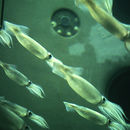Comprehensive Description
provided by Smithsonian Contributions to Zoology
Illex illecebrosus (Lesueur, 1821)
DIAGNOSIS.—Hectocotylus (see Figure 1) with distal hectocotylized portion of arm IV (HA3) limited to about 22% (13%–30%) of total arm length (HALt); papillae and lamellae weakly developed; basal, suckerless part (HAb) of hectocotylized arm short, about 6% of total arm length; proximal sucker-bearing part (HA1) with 7 to 8 pairs of normal suckers increasing in diameter distally; distal sucker-bearing part (HA2) with slight secondary modification of reduction in sucker diameter compared to normal proximal suckers; oral surface of arm IV not expanded, sucker rows not abnormally separated; very slight muscular constriction in transition zone between proximal (HA1) and distal (HA2) sucker-bearing parts; trabeculae not modified as fringed lobes; hectocotylized arm shorter than or equal to its opposite arm in length and always equal in thickness. Club expanded; largest distal medial manal sucker rings smooth, without crenulations or notches. Head-width index low, 16.3–17.0. Lower beak with jaw edge straight, short; wing long, wide, no lobe; rostral width narrow; lateral wall short, blunt. Upper beak with hood long, strong; shoulder serrated; rostrum long; wing short; jaw angle with large notch, with tooth; lateral wall short, shallow; crest curved. Fin angle mostly 45° (40°–50°), never > 50°. Spermatophore cone at oral end of cement body, a low, right-isosceles triangle with rounded corners in outline; oral tube long, narrow; aboral neck long, narrow.
ORIGINAL DESCRIPTION.—Lesueur, 1821:95.
TYPE LOCALITY.—Sandy Bay, Massachusetts, United States.
TYPE.—No types were designated. The single specimen illustrated by Lesueur when he caught it at Sandy Bay would have been the holotype (1821:95), but that specimen was not retained according to Lesueur. Based on Lesueur's description and comments, this appears to have been the only specimen available. Extensive searches (individually by CCL, CFER, and G.L. Voss) at the Academy of Natural Sciences, Philadelphia, other museums in the United States, and the Museum National d'Histoire Naturelle, Paris, confirm that no specimen in any way applicable as a holotype or as a neotype is extant.
DESIGNATION OF NEOTYPE.—In the absence of any original type material, and because of exceptional circumstances described below, it is necessary to designate a neotype as follows: mature male, 199 mm ML, National Museum of Natural History, Smithsonian Institution, USNM 727456, Figure 2; measurements, indices, and counts of the neotype are given in Table 1.
Character Measurement (mm) Index (%)
ML 199
VML 188 94.5
HL 34.4 17.3
HW 27.5 13.8
MW1 30.8 15.5
MW2 35 17.6
MW3 18.6 9.4
FL 85 42.7
FW 111 55.8
FbL 76 38.2
AL,I 74 37.2
AL,II 95 47.7
AL,III 94 47.2
AL,IV 85 42.7
HALt* 88 44.2
HAb 8 9
HA1 28 32
HA2 35 40
HA3 17 19
CL 49 24.6
AS,I 2.6 1.31
AS,II 4.0 2.01
AS,III 3.9 1.96
AS,IV 2.1 1.06
CIS 2.8 1.41
GL 65 32.7
SpL 21 10.6
SpRL 14.5 69.1
SpRW 0.3 1.43
CBL 2.8 13.3
FA 41°
ASC,I 102
ASC,II 100
ASC,III 98
ASC,IV 119
GiLC 69
*Right arm IV hectocotylized.
The International Commission on Zoological Nomenclature (ICZN) (Art. 75(b), 1985:157) stipulates that a neotype can be designated “only in exceptional circumstances…in the interests of stability of nomenclature.” In the case of I. illecebrosus, the exceptional circumstances occurred with the simultaneous description of I. oxygonius and the recognition of this new species and I. coindetii as sympatric with I. illecebrosus in the western North Atlantic (Roper et al., 1969). The range of interand intraspecific variability of characters makes species identification very difficult. A major international fishery exists for I. illecebrosus in the north, and it extends southward into the area of sympatry off the mid-Atlantic States. Consequently, all three species are involved in the fishery in the area of sympatry. Any type of rational exploitation and management plan must take into account the three very similar species. The designation of clearly defined neotypes for Illex illecebrosus and I. coindetii (see below) therefore is necessary for nomenclatural stability.
NEOTYPE LOCALITY.—Old Scantum grounds, 12–16 km (8–10 miles) southeast of the Isles of Shoals, New Hampshire, United States, southwest edge of Jeffery's Basin, approximately 43°N, 70°30′W, 17-VIII-1971; otter trawl at 117 m; fishing vessel Osprey, Capt. R.A. Stetson, Rye, New Hampshire; collected by C.F.E. Roper. This locality is about 34 km north of Sandy Bay, Massachusetts, Lesueur's type locality.
GEOGRAPHICAL DISTRIBUTION.—Western North Atlantic Ocean from 66°N (Iceland, southern Greenland, Baffin Island) southward to around 29°N in the Straits of Florida (Figure 3). Illex illecebrosus is a primarily neritic species that normally inhabits continental shelf and upper slope waters.
- bibliographic citation
- Voss, N. A. and Sweeney, M. J. 1998. "Systematics and Biogeography of cephalopods. Volume II." Smithsonian Contributions to Zoology. 277-599. https://doi.org/10.5479/si.00810282.586.277

